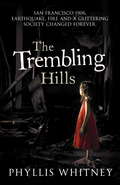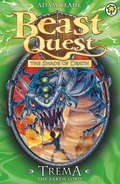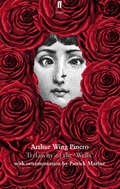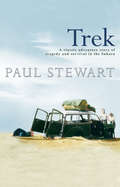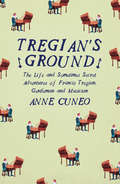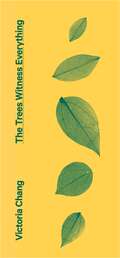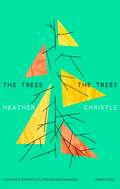- Table View
- List View
The Trembling Mountain: A Personal Account of Kuru, Cannibals, and Mad Cow Disease
by Robert KlitzmanKuru, like Mad Cow disease, is caused by a rare, infectious crystal protein that invades and colonizes human cells, destroying the nervous system of its victims. There is no known cure. It flourished in one of the remotest places on earth, Papua New Guinea, among the Fore, a people living in the Stone Age, who until recently practiced ritual cannibalism, consuming the brains of their forebears during funerary feasts. Robert Klitzman helped establish the links between these rituals and kuru. What he discovered has provided keys to understanding the mysterious Mad Cow Disease, which may become the world's next major epidemic. Robert Klitzman was 21 years old when he was invited by the Nobel prize-winning scientist Dr. Carleton Gajdusek, then at the National Institutes of Health, to conduct original research on kuru. Seizing the chance to travel to the other end of the world, Klitzman embarked on an adventure that would change his life.
The Trembling Mountain: A Personal Account of Kuru, Cannibals, and Mad Cow Disease
by Robert KlitzmanKuru, like Mad Cow disease, is caused by a rare, infectious crystal protein that invades and colonizes human cells, destroying the nervous system of its victims. There is no known cure. It flourished in one of the remotest places on earth, Papua New Guinea, among the Fore, a people living in the Stone Age, who until recently practiced ritual cannibalism, consuming the brains of their forebears during funerary feasts. Robert Klitzman helped establish the links between these rituals and kuru. What he discovered has provided keys to understanding the mysterious Mad Cow Disease, which may become the world's next major epidemic. Robert Klitzman was 21 years old when he was invited by the Nobel prize-winning scientist Dr. Carleton Gajdusek, then at the National Institutes of Health, to conduct original research on kuru. Seizing the chance to travel to the other end of the world, Klitzman embarked on an adventure that would change his life.
The Trembling Hills: The Turquoise Mask, The Trembling Hills, And The Quicksilver Pool
by Phyllis WhitneyThe nights of Sara's childhood had been haunted by dreams of a candlelit figure glimpsed in a mirror but by day she was bright, passionate and indomitable. In spite of her mother's opposition she decides to follow her benefactor's son Ritchie Temple to San Francisco. He had always been the man for her. But Sara could not know about the terrors that were in store for her. For it was in the towering old Varady mansion that she was suddenly to find her childhood nightmare turning into reality and her dreams turned to dust by the terrible secrets from the past.
Tremble: Sensual Tales Of The Mystical And Sinister
by Tobsha LearnerWho do you want to be with tonight? Step into the dark realm of erotic fantasy with Tobsha Learner's sizzling short story collection. Prepare to be shocked and seduced as this internationally famous writer turns a practiced hand to erotic romance. Make no mistake, Tremble will consume you, possess you, and leave you begging for more... 'She is sharp-eyed, literate, socially aware, brave, sardonic and unabashed' Australian'Convincing characters and well-crafted prose. Learner is that rare beast: a wordsmith who can spin a yarn' The Times"Erotically charged... these nine wonderfully strange and dark tales maintain a dreamy, fairy-tale feel" Publisher's Weekly, Starred Review
The Tremarnock Series Box Set (Tremarnock)
by Emma Burstall'I fell in love with the Cornish coastal town of Tremarnock and its residents.' NetGalley 5* ReviewReturn to the Cornish coast with Emma Burstall's irresisitible Tremarnock series. Escape to the beautiful seaside village of Tremarnock, and follow the ups and downs of its close-knit community: their tensions, ambitions – and secrets.Collected in a single volume for the first time, this is the five novels in Emma Burstall's Tremarnock series:STARTING OVER IN CORNWALL CHRISTMAS AT THE CORNISH GUEST HOUSE A SUMMER IN CORNWALL A CORNISH SECRET THE GIRL WHO CAME HOME TO CORNWALL'Burstall is a great writer... I was gripped from the start' Daily Mail 'Burstall has created a little sanctuary, which will have readers eager to book a Cornish holiday as soon as possible' Bookbag
Trema the Earth Lord: Series 5 Book 5 (Beast Quest #29)
by Adam BladeFearsome Trema lurks in the bowels of the earth, only emerging to feast on his prey. If Tom is to defeat the Beast and lift the curse on Freya, the Mistress of the Beasts, he has no choice but to brave the underworld. But a terrible shock is waiting for him above ground...Don't missKRABB, MASTER OF THE SEA - HAWKITE, ARROW OF THE AIR - KOLDO THE ARCTIC WARRIOR - ROKK THE WALKING MOUNTAIN - AMICTUS THE BUG QUEEN
Trellises and Trellis-Based Decoding Algorithms for Linear Block Codes (The Springer International Series in Engineering and Computer Science #443)
by Shu Lin Tadao Kasami Toru Fujiwara Marc FossorierAs the demand for data reliability increases, coding for error control becomes increasingly important in data transmission systems and has become an integral part of almost all data communication system designs. In recent years, various trellis-based soft-decoding algorithms for linear block codes have been devised. New ideas developed in the study of trellis structure of block codes can be used for improving decoding and analyzing the trellis complexity of convolutional codes. These recent developments provide practicing communication engineers with more choices when designing error control systems. Trellises and Trellis-based Decoding Algorithms for Linear Block Codes combines trellises and trellis-based decoding algorithms for linear codes together in a simple and unified form. The approach is to explain the material in an easily understood manner with minimal mathematical rigor. Trellises and Trellis-based Decoding Algorithms for Linear Block Codes is intended for practicing communication engineers who want to have a fast grasp and understanding of the subject. Only material considered essential and useful for practical applications is included. This book can also be used as a text for advanced courses on the subject.
Trellis Decoding of Block Codes: A Practical Approach (The Springer International Series in Engineering and Computer Science #391)
by Bahram Honary Garik MarkarianIt is a great pleasure to be asked to write the Preface for this book on trellis decoding of error correcting block codes. The subject is extremely significant both theoretically and practically, and is very timely because of recent devel opments in the microelectronic implementation and range of application of error-control coding systems based on block codes. The authors have been notably active in signal processing and coding research and development for several years, and therefore very well placed to contribute to the state of the art on the subject of trellis decoding. In particular, the book represents a unique approach to many practical aspects of the topic. As the authors point out, there are two main classes of error control codes: block codes and convolutinal codes. Block codes came first historically and have a well-developed mathematical structure. Convolutional codes come later, and have developed heuristically, though a more formal treatment has emerged via recent developments in the theory of symbolic dynamics. Max imum likelihood (ML) decoding of powerful codes in both these classes is computationally complex in the general case; that is, ML decoding fails into the class of NP-hard computational problems. This arieses because the de coding complexity is an exponential function of key parameters of the code.
Trellis and Turbo Coding: Iterative and Graph-Based Error Control Coding (IEEE Series on Digital & Mobile Communication)
by Christian B. Schlegel Lance C. PerezThis new edition has been extensively revised to reflect the progress in error control coding over the past few years. Over 60% of the material has been completely reworked, and 30% of the material is original. Convolutional, turbo, and low density parity-check (LDPC) coding and polar codes in a unified framework Advanced research-related developments such as spatial coupling A focus on algorithmic and implementation aspects of error control coding
Trellis and Turbo Coding: Iterative and Graph-Based Error Control Coding (IEEE Series on Digital & Mobile Communication)
by Christian B. Schlegel Lance C. PerezThis new edition has been extensively revised to reflect the progress in error control coding over the past few years. Over 60% of the material has been completely reworked, and 30% of the material is original. Convolutional, turbo, and low density parity-check (LDPC) coding and polar codes in a unified framework Advanced research-related developments such as spatial coupling A focus on algorithmic and implementation aspects of error control coding
Trelawny of the 'Wells': An Original Comedietta
by Arthur Wing PineroLondon, the 1860s. Rose Trelawny is the brightest young star at the Sadler's Wells Theatre. But she's prepared to give it all up for the love of her noble stage door suitor, Arthur Gower. Meanwhile, her colleague at the 'Wells', Tom Wrench, is writing a new kind of play for Rose to star in. And her friend, Imogen Parrott, hopes to take a theatre in which to produce it. Rose will be forced to choose between her two great loves. Set amongst theatrical folk and the non-theatricals they seek to please and provoke, Trelawny of the 'Wells', by Arthur Wing Pinero, premiered at the Royal Court Theatre, London, in January 1898. This version, with revisions and additions by Patrick Marber, premiered at the Donmar Warehouse, London, in February 2013.
Treks into Intuitive Geometry: The World of Polygons and Polyhedra
by Jin Akiyama Kiyoko MatsunagaThis book is written in a style that uncovers the mathematical theories buried in our everyday lives such as examples from patterns that appear in nature, art, and traditional crafts, and in mathematical mechanisms in techniques used by architects. The authors believe that through dialogues between students and mathematicians, readers may discover the processes by which the founders of the theories came to their various conclusions―their trials, errors, tribulations, and triumphs. The goal is for readers to refine their mathematical sense of how to find good questions and how to grapple with these problems. Another aim is to provide enjoyment in the process of applying mathematical rules to beautiful art and design by examples that highlight the wonders and mysteries from our daily lives. To fulfill these aims, this book deals with the latest unique and beautiful results in polygons and polyhedra and the dynamism of geometrical research history that can be found around us. The term "intuitive geometry" was coined by Lászlo Fejes Tóth to refer to the kind of geometry which, in Hilbert's words, can be explained to and appeal to the "man on the street." This book allows people to enjoy intuitive geometry informally and instinctively. It does not require more than a high school level of knowledge but calls for a sense of wonder, intuition, and mathematical maturity.
Treks into Intuitive Geometry: The World of Polygons and Polyhedra
by Jin Akiyama Kiyoko MatsunagaThis book is written in a style that uncovers the mathematical theories hidden in our daily lives, using examples of patterns that appear in nature, arts, traditional crafts, as well as mathematical mechanics in architectural techniques. The authors believe that through conversations between students and mathematicians, readers may learn about the methods used by the originators of these theories―their trials, errors, and triumphs―in reaching their various conclusions. The goal is to help readers refine their mathematical sense in terms of formulating valuable questions and pursuing them. In addition, the book aims to provide enjoyment in the application of mathematical principles to beautiful art and design by using examples that highlight the wonders and mysteries of these works found in our daily lives. To achieve these goals, the book tackles the latest exquisite results on polygons and polyhedra and the dynamic history of geometric research found around us. The term "intuitive geometry" was coined by Lászlo Fejes Tóth and refers to the kind of geometry which, in Hilbert's words, can be explained to and appeal to the "man on the street." This book enables readers to enjoy intuitive geometry informally and instinctively. It does not require more than a high school level of knowledge but calls for a sense of wonder, intuition, and mathematical maturity. In this second edition, many new results, and elegant proofs on a variety of topics have been added, enhancing the book’s rich content even further.
Trekking the Shore: Changing Coastlines and the Antiquity of Coastal Settlement (Interdisciplinary Contributions to Archaeology)
by Nuno F. Bicho, Jonathan A. Haws and Loren G. DavisHuman settlement has often centered around coastal areas and waterways. Until recently, however, archaeologists believed that marine economies did not develop until the end of the Pleistocene, when the archaeological record begins to have evidence of marine life as part of the human diet. This has long been interpreted as a postglacial adaptation, due to the rise in sea level and subsequent decrease in terrestrial resources. Coastal resources, particularly mollusks, were viewed as fallback resources, which people resorted to only when terrestrial resources were scarce, included only as part of a more complex diet. Recent research has significantly altered this understanding, known as the Broad Spectrum Revolution (BSR) model. The contributions to this volume revise the BSR model, with evidence that coastal resources were an important part of human economies and subsistence much earlier than previously thought, and even the main focus of diets for some Pleistocene and early Holocene hunter-gatherer societies. With evidence from North and South America, Europe, Africa, Asia, and Australia, this volume comprehensively lends a new understanding to coastal settlement from the Middle Paleolithic to the Middle Holocene.
Trek
by Paul Stewart1955, Kenya. A group of four acquaintances set out to drive from Nairobi to London, via the Sahara desert, in a 8 horse-power Morris Traveller. Under the leadership of Alan Cooper, a down-on-his-luck farmer, the group was made up of a worldly field biologist who recorded the whole trip on her 8mm cine camera, a genteel schoolmistress of uncertain age in search of romance, and a 17-year-old boy whose mother had insisted that the trip would make a man of him. What united them was a desire for adventure.As they set off through Equatorial Africa the omens seemed against them. The Mau Mau uprising against British rule in Kenya was at it's height and the days of colonial rule were ending. Their journey was to take them through an Africa that very soon would cease to exist. But it was the desert that turned their joyride into a nightmare. What began as an adventure ended as a desperate fight for life in the blazing sands of the Sahara. Trek brings this story to dramatic life and is a classic account of survival against the odds.
Tregian's Ground: The Life and Sometimes Secret Adventures of Francis Tregian, Gentleman and Musician
by Anne CuneoThe significance of the Fitzwilliam Virginal Book to our musical canon is well known; the remarkable story of its copyist and compiler, Francis Tregian, less so. Born into Cornish Catholic nobility and plumb into the choppy waters of the Elizabethan Age, he must rely on his surpassing skill as a musician to survive.In this Prix des Libraires (Booksellers Prize) winning novel, Anne Cuneo deftly recreates the musician’s journey across Renaissance Europe, which sees him befriending Shakespeare, swapping partitions with William Byrd and Monteverdi, and playing in the court of Henri IV of France.The result is as gripping as it is authentic: an epic, transcontinental choreography in which Europe’s monarchs tussle with pretenders to their thrones, and ordinary people steer between allegiances to God, nation and family.Complete with links to live performances and to recordings of selected musical sources in the Tregian's Ground Discography.
Treewidth, Kernels, and Algorithms: Essays Dedicated to Hans L. Bodlaender on the Occasion of His 60th Birthday (Lecture Notes in Computer Science #12160)
by Fedor V. Fomin Stefan Kratsch Erik Jan van LeeuwenThis Festschrift was published in honor of Hans L. Bodlaender on the occasion of his 60th birthday. The 14 full and 5 short contributions included in this volume show the many transformative discoveries made by H.L. Bodlaender in the areas of graph algorithms, parameterized complexity, kernelization and combinatorial games. The papers are written by his former Ph.D. students and colleagues as well as by his former Ph.D. advisor, Jan van Leeuwen.
Treetops at Risk: Challenges of Global Canopy Ecology and Conservation
by Margaret Lowman, Soubadra Devy and T. GaneshForest canopies not only support high terrestrial biodiversity but also represent a critical interface between the atmosphere and the earth. They provide goods and services to support diverse human communities and offer opportunities to explore sustainable use of these resources for many generations of local livelihoods. Forest canopies are important carbon sequestration units, and in this sense, serve as climate control for the planet. Canopies are important energy production centers for the planet, and serve as the basis for many food chains. The canopy can also act as a hook for education outreach and conservation, inspiring ecotourism through recreation and other sustainable uses such as treetop walks, zip lines, and birding. Despite these critical services provided by forest canopies, almost no dedicated research in the treetops was initiated until as recently as the late 1970s when single rope techniques were developed by mountaineering professionals and adapted for use in the canopy. Subsequently, an array of canopy access tools was designed in the 1980s and early 1990s that have opened up this “eighth continent” for global exploration and discovery.This volume uses the major findings of the 5th international canopy conference as a platform for organization, but it does not mimic the sessions and presentations of the conference itself. Instead, it builds on the important themes that emerged from the conference and solicits articles that represent future priorities and advancements for canopy science in the next decade. Despite the global efforts of hundreds of forest scientists over the past 3 decades, forests are degrading at an accelerated rate and biodiversity is increasingly threatened by human activities. Given these trends - despite the very best efforts of the world’s best scientists - other approaches must be taken. This volume summarizes the issue of “treetops at risk” and assembles a global authorship to examine past accomplishments and future initiatives critical in forest conservation.
The Trees Witness Everything
by Victoria ChangA lover of strict form, best-selling poet Victoria Chang turns to compact Japanese waka, powerfully innovating on tradition while continuing her pursuit of one of life's hardest questions: how to let go.In The Trees Witness Everything, Victoria Chang reinvigorates language by way of concentration, using constraint to illuminate and free the wild interior. Largely composed in various Japanese syllabic forms called 'wakas,' each poem is shaped by pattern and count. This highly original work innovates inside the lineage of great poets including W.S. Merwin, whose poem titles are repurposed as frames and mirrors for the text, stitching past and present in complex dialogue. Chang depicts the smooth, melancholic isolation of the mind while reaching outward to name - with reverence, economy and whimsy - the ache of wanting, the hawk and its shadow, our human urge to hide the minute beneath the light.
The Trees The Trees
by Heather Christle'Heather Christle's poems may well be one of the places readers turn when they want to know what it was like to be young and paying attention in the early 21st century . . . Her poems are wide awake' Mark DotyIn The Trees The Trees, each new line is a sharp turn toward joy and heartbreak, and each poem unfolds like a bat through the wild meaninglessness of the world.'At least once per poem, you feel like the triple-bars just lined up in the slot machine window and you laugh or cry out' John Darnielle'Ecstatic, breathless, full of incandescent humour and wonder . . . Read and love her seemingly spontaneous utterances, spun from her rapt attention to daily life, nature, solitude, romance, to her own reeling and enchanting imagination' Cathy Park Hong'Heather Christle's poems are magical' James Tate
The Trees that made Britain
by Archie MilesAs the oldest living inhabitants on the planet, trees have played a major part in the way we live today, providing both the daily oxygen we breathe and the foundation of our nations heritage. Every native tree in Britain, whether its part of a grand avenue, a thriving hedgerow, an ancient wood or a colourful orchard, tells a different story. Accompanying a fascinating and lively BBC series, The Trees That Made Britain takes us on a journey of discovery to every corner of the nation. Through detailed portraits of individual tree species, author and photographer Archie Miles reveals the stories of the trees that have influenced the culture, myths and fabric of the nation. The book is full of surprising facts on how trees have been used by man over the centuries, from the oak used in the building of HMS Victory to ancient longbows made from yew, as well as practical advice on visiting some of Britains finest living examples. The combination of rich historical material and lyrical descriptions captures the essence of our native tree species. Lavishly illustrated, The Trees That Made Britain is a celebration of the beauty and wonder of trees, and their awe-inspiring legacy.
The Trees that Made Britain: Revised Edition
by Archie MilesAs the oldest living inhabitants on the planet, trees have played a major part in the way we live today, providing both the daily oxygen we breathe and the foundation of our nations heritage. Every native tree in Britain, whether its part of a grand avenue, a thriving hedgerow, an ancient wood or a colourful orchard, tells a different story. The Trees That Made Britain takes us on a journey of discovery to every corner of the nation. Through detailed portraits of individual tree species, author and photographer Archie Miles reveals the stories of the trees that have influenced the culture, myths and fabric of the nation. The book is full of surprising facts on how trees have been used by man over the centuries, from the oak used in the building of HMS Victory to ancient longbows made from yew, as well as practical advice on visiting some of Britains finest living examples. The combination of rich historical material and lyrical descriptions captures the essence of our native tree species.
Trees, People and Power: Trees, People And Power (Natural Resource Management Set)
by Peter UttingBehind the headlines about the loss of tropical forests in Latin America lies a complex and fascinating story of the social pressures which cause it. Trees, People and Power looks at the various groups, interests and conflicts involved, and explores the repercussions for forestry, the environment and the livelihoods of the rural and urban poor. Until the social and political dimensions of deforestation and forest protection schemes are understood, measures to prevent or slow deforestation are likely to involve technical interventions which will prove ineffective in the long run, and may well result in further impoverishment and environmental degradation. Peter Utting takes a critical look at the experience of forest protection and tree planting in a number of countries and considers how social and political factors affect the feasability of such schemes. Many environmental projects and programmes have failed to balance concerns for the environment with those of human welfare. Until they do, it is unrealistic to expect any significant progress towards sustainable development. Peter Utting is a senior researcher coordinator with the United Nations Research Institute for Social Development. He is the author of Economic Adjustment under the Sandinistas (UNRISD, 1991) and Economic Reform and Third World Socialism (Macmillan, 1992). Originally published in 1993
Trees, People and Power (Natural Resource Management Set)
by Peter UttingBehind the headlines about the loss of tropical forests in Latin America lies a complex and fascinating story of the social pressures which cause it. Trees, People and Power looks at the various groups, interests and conflicts involved, and explores the repercussions for forestry, the environment and the livelihoods of the rural and urban poor. Until the social and political dimensions of deforestation and forest protection schemes are understood, measures to prevent or slow deforestation are likely to involve technical interventions which will prove ineffective in the long run, and may well result in further impoverishment and environmental degradation. Peter Utting takes a critical look at the experience of forest protection and tree planting in a number of countries and considers how social and political factors affect the feasability of such schemes. Many environmental projects and programmes have failed to balance concerns for the environment with those of human welfare. Until they do, it is unrealistic to expect any significant progress towards sustainable development. Peter Utting is a senior researcher coordinator with the United Nations Research Institute for Social Development. He is the author of Economic Adjustment under the Sandinistas (UNRISD, 1991) and Economic Reform and Third World Socialism (Macmillan, 1992). Originally published in 1993

